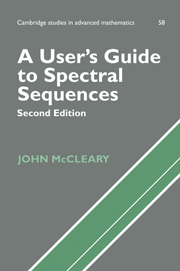12 - Spectral sequences in Algebra, Geometry and Analysis
Published online by Cambridge University Press: 19 January 2010
Summary
“During the last decade the methods of algebraic topology have invaded extensively the domain of pure algebra, and initiated a number of internal revolutions.”
From [Cartan-Eilenberg56]Spectral sequences arise from filtered differential modules, from double complexes, and from exact couples (Chapter 2). These basic structures may be found in almost any situation where homological methods are used—many examples of spectral sequences have become essential tools in fields outside of topology.
In this chapter, we continue the catalogue begun in Chapter 11. The examples here fall into three broad classes: those of homological origin (§12.1); those based on algebraic or differential geometric structures (§12.2), and those whose origin is chiefly topological but whose interpretation is algebraic (§12.3). We close the chapter with a short discussion of the notion of derived categories (§12.4), a formalism that lurks behind the ‘unreasonable effectiveness’ of spectral sequences.
The reader is expected to be acquainted with the categories of discourse for the examples presented in this chapter—definitions can be found in the cited references. Furthermore, this catalogue is quite far from complete (though some might argue that inclusion of Grothendieck's composite functor spectral sequence excludes very few examples). The hope remains that the reader will find a useful example in this collection or at least the sense in which spectral sequences can be applied in his or her field of interest. A search of the review literature in mathematics will provide a bounty of details to the curious reader.
Spectral sequences for rings and modules
Suppose R and S are commutative rings with unit.
- Type
- Chapter
- Information
- A User's Guide to Spectral Sequences , pp. 507 - 524Publisher: Cambridge University PressPrint publication year: 2000

